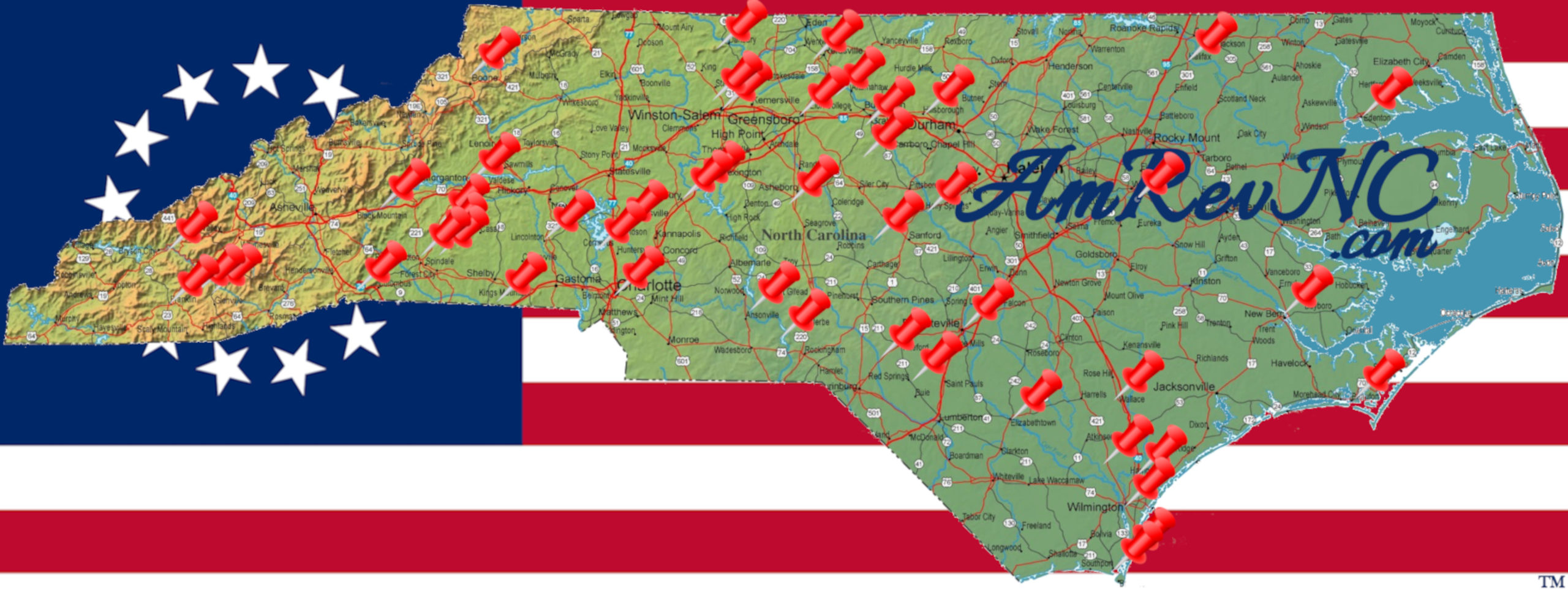March with Rutherford
From Davidson’s Fort, the fastest route to the next stop on the Cherokee Tour uses I-40 most of the way. Mapping applications will use that route.
If you wish to stay as close as possible to the original path taken by Rutherford’s army in both directions—the “Rutherford Trace”—use these directions. The portion over Swannanoa Gap is a dirt or gravel road (Step #6). Though relatively smooth, it is likely impassable for many vehicles in winter or after heavy rains.
Directions
To Asheville
All mileage numbers are approximate. From the Davidson Fort Historic Park:
- Turn right out of the park.
- Drive 0.5 miles, and then turn right across the railroad tracks.
- Turn left at US 70 (East Main Street).
- Drive 0.3 miles and take a right at Old US Highway 70.
- Drive 2.5 miles and turn right on Mill Creek Road (SR 1407).
Note: The army probably continued straight uphill, which now becomes a trail that rejoins the auto route on the far side of the peak. - Drive 6.4 miles and just before I-40, turn right at the unmarked road (Old US 70).
Note: You will pass a Civil War Trails site on the left after returning to pavement. Where you turn onto Old 70, the army began following the Swannanoa River, all the way to the French Broad River in modern Asheville. - Drive 2.4 miles to Flat Creek Road in Black Mountain, and then turn left and right onto US 70.
Note: Two soldiers in the army reported it marched 10 miles the first day, which puts its camp somewhere along the river in today’s Black Mountain.[a]
Through Town
- Drive 3.0 miles through town and turn right on Grovestone Road.
- Drive 0.3 miles and turn left at the stoplight (unmarked Old US 70).
- Drive 2.9 miles to Riverwood Road and turn left.
- Cross the Swannanoa River, and turn right on US 70.
- Drive 4.9 miles on US 70 as it becomes Tunnel Road, and turn left on Swannanoa River Road (NC 81).
- Drive 6.4 miles, continuing straight across Biltmore Avenue onto Meadow Road.
Note: Do not follow NC 81 to the left at Biltmore. - Turn left onto Amboy Road and cross the bridge over the French Broad River.
Note: The army used War (or Warrior) Ford. Its exact location is lost, but an officer reports they crossed the French Broad “near the mouth of the Swannanoa,” which is a short distance south (left) of the bridge.[b] Since bridges were sometimes built on fords, it could be here. They next picked up Hominy Creek, whose mouth is roughly 2.5 miles along the river in the direction you are driving - Stay on Amboy Road as it empties into I-26/240 West.
Next Tour Stop
- Take the second exit onto I-40 West.
- Stay in the right lane to take Exit 44, US 19/23 West (Smoky Park Highway).
Note: The remaining steps skip part of the Rutherford Trace for which there is no easy drive. The army followed winding Hominy Creek along this stretch. - At the bottom of the exit ramp, turn right and go under the interstate.
- Take the first right, Acton Court.
Note: For this and the next step, follows the signs for the Buncombe County Sports Park. - Follow Acton as it curves left, and at the top of the hill turn left onto Sand Hill School Road.
- Drive 0.3 miles and take the first right after the sports complex, Captain’s Drive.
Refer to the “William Moore Homesite and Grave” page at this point.
[a] William Dells (Dells, ‘A Journal of the Motions of the Continental Army Commanded by the Honble. Griffith Rutherford Esqr. Brigadear Generall Against the Cherokee Indians’, 1776, The Filson Historical Society, Arthur Campbell Papers, Mss. A C187 26, William Dells Military Journal <https://filsonhistorical.org/wp-content/uploads/FHS-Mss-A-C187-26-William-Dells-Military-Journal.pdf> [accessed 26 January 2023]) and Lt. William Lenoir (Hamilton, J. G. de Roulhac, ‘Revolutionary Diary of William Lenoir’, The Journal of Southern History, 6.2 (1940), 247–59 <https://doi.org/10.2307/2191209>.
[b] Lenoir, William, ‘Account of the Expedition against the Cherokee Indians, in 1776, under Gen’l Griffith Rutherford’, 1835, Museum of the Cherokee Indian Archive, 2010.253.0207, Rutherford Expedition: Miscellaneous.
